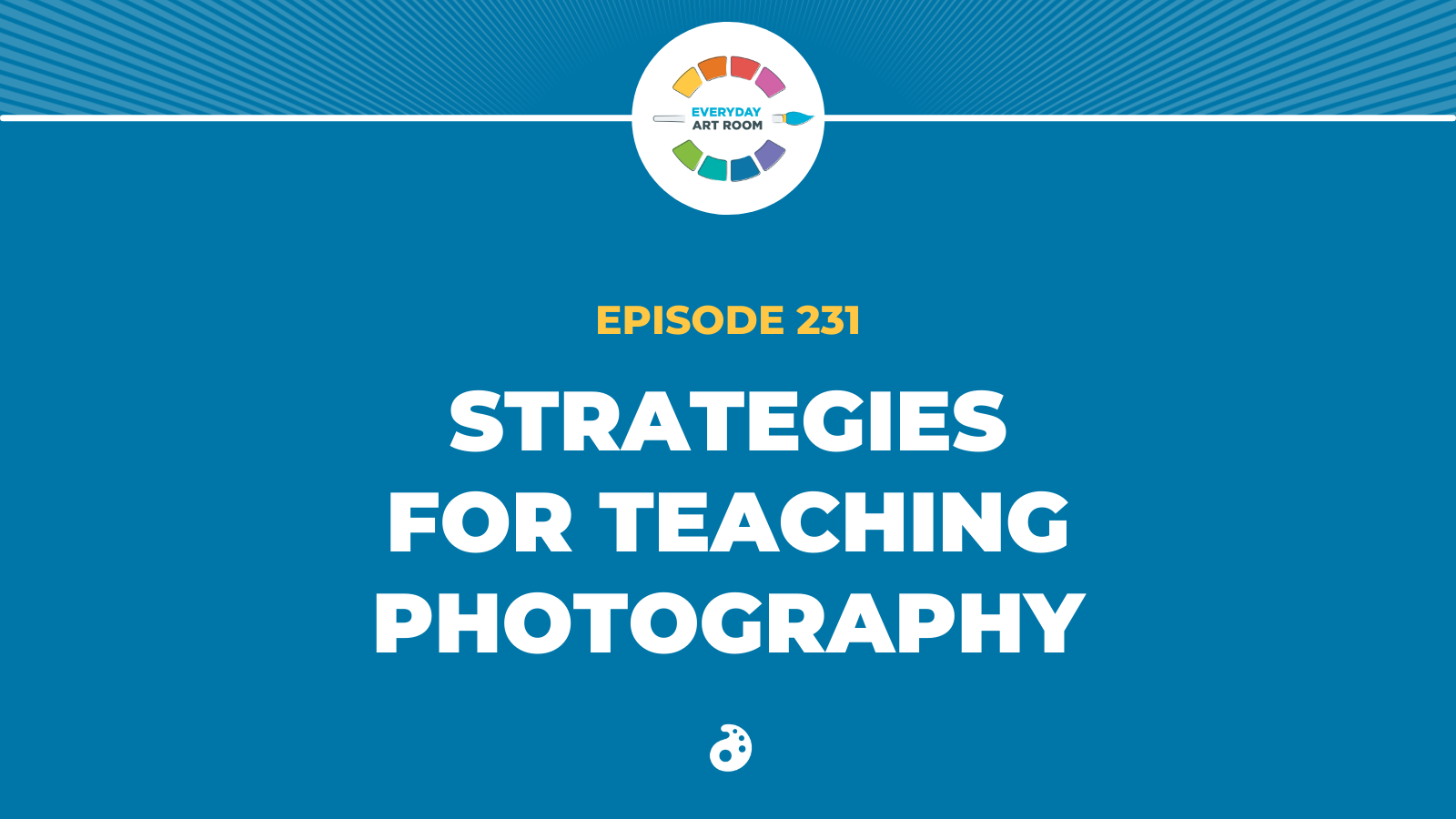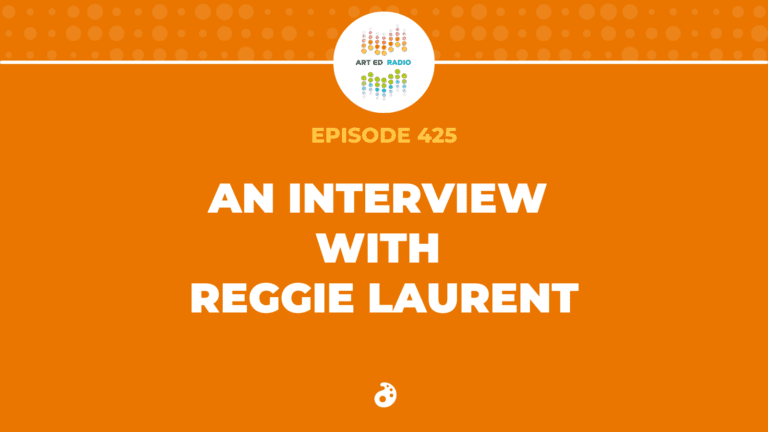Photography—with all of its necessary equipment, knowledge, and technology—can be a difficult medium to teach. Today’s episode tries to break down some of those barriers and tell you how you can bring photography to the elementary and middle school level. Listen as Sarah DeKett joins Candido to talk about organization, lessons, creativity, and how she started a photography program without a budget. Full Episode Transcript Below.
Resources and Links
- How to Bring Photography Into Any Art Class
- 2 Engaging Projects for Beginning Photography Students
- How to Get Your Students Thinking Deeply With Photography
- View Sarah’s Photography Classroom Website

Transcript
Candido: There were some absolutely incredible presentation at this year’s NAEA conference in New York City. Unfortunately, there were so many that I wasn’t able to attend them all. Thankfully, my friends and colleagues shared some of their experiences and the contacts they made. Among those I missed was Sarah DeKett’s presentation on middle school photography. I’m upset I missed this one, as photography has been a skill I’ve wanted to teach for a while. During her presentation, she discussed materials and technology used in her class, as well as lesson plans. Fortunately, Sarah’s able to join us and share some of this very valuable information and we’ll see if we can make it all work for an elementary level as well. This is Everyday Art Room, and I’m your host, Candido Crespo.
Sarah, I’m so excited you were able to join us. But first, before we get in, before we dive deep into our topic, can you please just enlighten us with where you teach and who you teach?
Sarah: Yeah. I teach in Northern Michigan. I teach in Traverse City. It’s a little town on Lake Michigan and I teach sixth through eighth grade right now. Middle school level, sixth through eighth grade in one building.
Candido: Okay. It’s funny that you say one building because there is a backstory to you mentioning that. Can you tell us what your situation was prior to being in one building?
Sarah: Yeah, so I taught 11 years of high school or I was the only art teacher in the building. Everything I did was solo, was kind of a little island to myself and then I moved to Traverse City and I got hired as an elementary art teacher, but I was in four different buildings. Two buildings a day, most days of the week and now at the middle school level, one building, one room, no travel.
Candido: Good for you.
Sarah: Thanks.
Candido: Okay. I have mentioned in the past, in this podcast and other presentations, how important I think it is for art teachers to be creative and to practice their own form of art whenever they have an opportunity. Are you actively engaged in some type of practice?
Sarah: Photography has always been a passion and I did have a photography business. I did a lot of senior portraits. I did the sports portraits at the high school that I worked at, family portraits, I got into weddings and then I had a baby. He’s almost 11, he’s going to be 11 next week and that took up more time. I found myself spending more time with other people’s kids and families and weekends, and decided that I needed to focus on family more. Put the photography business aside, but definitely still actively creating mixed media, collage, found objects. That’s usually what I prefer to do right now.
Candido: Okay, great, great. Was it difficult finding the time to create once you became a parent or was it just making those decisions of what you wanted to make a priority?
Sarah: I think a little bit of both. You find yourself so focused on being a parent and being a teacher and trying to come home and turn that switch off and turn your creativity on just for yourself. It’s kind of hard to do. You get a little bit burnt out. Summertime is my favorite-
Candido: Okay.
Sarah: … because you get to focus more on yourself. It’s a lot harder to do it during the school year.
Candido: Yeah, yeah. I have the same feeling about it. It did take me a while to figure out how to make it happen. I think recently what I’ve started doing, especially with the project that I’m teaching now is creating with the students alongside them, but I’m not creating finished pieces or anything like that, but it’s keeping me from rusting up, right.
Sarah: Yes.
Candido: I’m drawing alongside them and I’m enjoying it and I get to show off to them and it makes me look like I’m a superhero in the classroom to them.
Sarah: I love it when they make you feel like a superhero.
Candido: Yeah. All right. You practice photography, but you also have the pleasure of teaching photography. Is this program that you are currently teaching, did you initiate this program or was it one that was existing and you started teaching within it?
Sarah: This particular one at the middle school already existed. It was something that started as a darkroom middle school photography before I was hired and then slowly transitioned to digital photography. When I taught at the high school level, I did initiate a photography class there. Being the only teacher, I always got input from the kids and they wanted a photography class. I did start a program at the high school level, but then transitioning to middle school, I just took over with one that already existed.
Candido: Okay. What happened to that darkroom?
Sarah: It’s gone, the whole building is gone. A new facility-
Candido: Okay.
Sarah: … and the new building that I’m in right now and unfortunately, I don’t know of many darkrooms that are left around.
Candido: Yeah. Our two darkrooms in our middle school and our high school are both just storage units at this point. They host all the old textbooks.
Sarah: Yeah, it’s sad.
Candido: Yeah, it is. Okay. The first thing that comes to mind when I hear about a photography program is budget and materials. It’s just the first thought that comes to mind. Can you tell us a little bit about maybe what you’re using in your program?
Sarah: Yeah, so right now the kids are using a variety of things. Sometimes they’re using cell phone cameras that they have at the seventh and eighth-grade level. I guess it’s a pro and a con that they have a cell phone at their fingertips at all times, but it’s something that I don’t have to budget if they have a camera on their hands, then it’s helpful. I do have some school cameras that were there already when I took over, some Canon PowerShots. Some kids use DSLR cameras that they have at home, and then they’ll bring in the SD cards.
But at the high school level, when I taught previously, it was a very low income situation and I didn’t have those capabilities and a lot of kids didn’t have cell phones at that time. I just put on an email to parents and families, “Does anybody have old digital cameras around that you’re not using?” Because at that time, cell phones and cell phone cameras were getting more and more popular. People aren’t using the old digital cameras that they have around and I did get a nice handful of cameras that kids were just able to use.
Candido: Wow, I didn’t even think about that. I’ve done that looking for other materials and other resources, but that thought of what people have done with their point and shoot cameras is-
Sarah: Yeah.
Candido: … is just… yeah. They’re probably just, like you said, they’re probably just sitting at home.
Sarah: Yes.
Candido: Because if you have a smartphone and you have a DSLR and that point and shoot camera is picking up dust somewhere-
Sarah: Yes.
Candido: … that’s good information. Yeah.
Sarah: Yeah.
Candido: It’s important that everybody listening to this podcast knows that I’m here learning just as much as you are today. I’m excited about the thought of possibly bringing a photography program to an elementary level.
Sarah: Yes.
Candido: I think that’s what I’m trying to do with this information and I’m sure that some of the listeners are probably thinking the same, how do we try to make this happen?
Sarah: Yeah.
Candido: But that immediately, that suggestion is a great starting point. Phones are a little bit different right at the elementary level.
Sarah: Yes.
Candido: I have occasionally have students that have it, but it’s not something that’s just very present. All right. We’ll keep talking and I’ll see what other pieces I can pull apart here.
All right. You’re using the cameras. Are you using laptops or iPads or anything like that?
Sarah: Our school is one-to-one, so each student has a Chromebook and that’s another thing, sometimes kids might be stuck somewhere where they don’t have access to a phone or don’t have access to a camera and the Chromebook does have a camera. It’s not going to be as many features that they have on other cameras, but it’s still something that you can take a photo with. Computer labs, if you don’t have access to a one-to-one device, perhaps going to a computer lab on days where the kids want to do editing, we had to do that at our high school level. We did not have one-to-one computers at the high school and you don’t need fancy photo editing either. We don’t have Photoshop on the Chromebooks, but you can have a lot of free web-based photo editing apps. Pixlr is the one I use, it seems to be the most user-friendly for middle school students. There are some other ones that you can do a little bit more advanced things with, but middle school level Pixlr is pretty easy.
Candido: Okay. Now another one of these follow up questions with budget is, did you always, did you have these initially or is this stuff that you just accumulated over time? I know the one-to-one’s, that was out of your control. That’s just something that they happen to have.
Sarah: Yeah.
Candido: But the cameras, it was that method. But part of it is just trying to think of the other in-class materials, did you have the budget in place for this to really build this up? I don’t know.
Sarah: Yeah. At the high school level, like I said, I had zero. I didn’t have a budget for it.
Candido: Okay.
Sarah: I actually wrote a grant to try to get a classroom set of Chromebooks in my room. I used DonorsChoose at that time, I’ve used AdoptAClassroom. Those are your great resources to try to get other donors to help you out. But the cameras at this particular school were already there and I think I have about 12 of them-
Candido: Okay.
Sarah: … and I have a class, my classes are sometimes 34, 36 kids. There’s definitely not a camera for every kid, but with group work and working in partners and sharing the cameras and having a whole week to do an assignment of shooting photos, there’s plenty of time for the kids to share the cameras.
Candido: Yeah. I was just about to ask that as soon as you said that number because that’s something that we encounter in my area as well, my district, is large class sizes. Do you ever like… Well, I guess the equivalent of working in stations, but some students will be taking photographs and the others are working on their Chromebooks or editing or something like that.
Sarah: Yeah. Typically, I’ll introduce a theme on a Monday and so they’ll have a whole week to shoot. It’s not going to be due until the following Tuesday. Then every other day that week we’re doing something in class whether it’s editing photos, learning a new editing technique, learning about a contemporary or historical photographer, critiquing our own photos, responding to videos. There’s always something that we’re doing and then they’re just working independently. It’s almost like I start the class with what we’re doing and then you’re either working on that assignment or shooting your pictures.
Candido: Okay, okay. That’s an idea of what your week is like. How important is art history in a photography class for you?
Sarah: I try to do a lot of contemporary photographers.
Candido: Okay.
Sarah: Because I think at the middle school level, it gets them a little more excited.
Candido: Sure.
Sarah: But I do still teach them at the beginning of the semester, I really talk about how did we get here? How did we get to a digital camera? Where did it… Because some kids don’t even know what a film camera was. They don’t know what-
Candido: Right.
Sarah: … a role of film was. That concept is over their head and so showing them this is what it looked like, this is what you had to do. You couldn’t open it up in the light. They have no concept of that and so showing them that history, I don’t dig too deep. It’s pretty quick. I don’t spend a lot of time on that, but just having them realize, whoa, that is pretty crazy.
Candido: I just thought about winding up the cameras to shoot.
Sarah: Yes.
Candido: Oh, man. It feels like so long ago.
Sarah: Yes.
Candido: That’s amazing.
Sarah: Yeah.
Candido: Wow.
Sarah: When I talk to them about Ansel Adams too, I talk to them about, he used filters and we’re not talking about a filter on your phone, he’s lugging equipment up the side of a mountain and putting a different color lens on his camera. He was using filters before you even knew what filters were. So…
Candido: Yeah, that’s right. The next question I want to ask is in part because I’m wondering how a lot of programs are infusing both their technology departments and their art departments. How, or rather not only how, but if you’ve had to do any type of steam work with your photography classes?
Sarah: I think that math is pretty easy to tie into photography, especially when you’re talking to them about perspective, forced perspective, symmetry. That’s a lot of stuff that’s really fun for them to make that connection between math and art.
Candido: Yeah.
Sarah: Forced perspective, we talk a lot about if you have a scale model. Let’s say you go to the store and you see a model car and it says that it’s a 1:24 scale model and then teaching them that, that’s actually how people in the film industry can save their budget, not use a giant tank, but use a scale model of a tank and using the ratios of that scale model. If you have a 1:24 scale model and you put that car one foot away from your camera and 24 feet away from the person that’s there, it’s going to make that tank look like it’s realistically scaled to size. Getting that math in their head is cool to see those connections for them.
Candido: Yeah. That’s great. Are you doing any animation or video work in these classes?
Sarah: I would say the closest we’ve got to video would be, I’ve taught them how to make an animated gif.
Candido: Okay.
Sarah: Doing selective color, so I have them take a color photo, turn it into black and white and then slowly reveal the color, saving it each time they change the color and then taking all of those files and turning it into an animation. Basically, turning their two dimensional photo into a three dimensional animation. It’s a pretty fun one.
Candido: All right, it does sound cool. Okay. Now I mentioned earlier that I was jealous that I wasn’t able to attend the presentation. Part of the reason is, you gave away free lessons. You were sharing all these awesome lessons. Thankfully, now I’ve been able to read up on them and check them out. But I was wondering maybe if you could share a few of them with us, maybe some of your favorites, some of the ones that you found more successful.
Sarah: Yeah. The kids love that forced perspective one because it’s fun to make people look larger than life and things look smaller than life. Symmetry is really fun for them because they can take an object, flip it and make it a perfectly mirrored symmetry work of art. They just finished up flat lay photography for me recently and that’s a fun one because they decide on a theme and they have to find objects that match the theme. I had a couple of kids do Legos or toys. I had some kids do food, so they’re thinking about, okay, if I, making a recipe and I am at home, I can lay out a rolling pin or some eggs and some measuring cups.
Or kids at school in the art room, they’re like, okay, my theme’s going to be art. I’m going to take some rulers and scissors and paint and they’re arranging it on a non-distracting background and shooting from above and filling the frame and it really makes them see how the things that they see on YouTube or on their social media feeds or in a magazine on how people advertise products, how you can do that on your own with photography. They really like that one.
Candido: Oh, I really like that one now too. Have you noticed that students care more about the photos they take as a result of being in your class?
Sarah: I do. I think that at first, it’s like, oh, I want to take a photography class because it’s just about taking pictures and they get excited about that. But when they realize that really anything that you’re interested in can be tied into any theme. One theme is line, anything can have line. If you’re interested in basketball, you can find lines in a basketball or the basketball hoop. If you’re interested in fashion, you can find lines in clothing. If you’re interested in science, you can find lines in the classroom when you’re doing a lab. You can find these themes anywhere, depending on what you’re interested in and at the middle school level, kids love themselves.
Candido: Of course.
Sarah: Anytime they can incorporate things that they like, they’re going to like it more.
Candido: Wow, okay, yeah. I thought that might have been an interesting aspect because it’s so easy to take photography for granted now, right.
Sarah: Yeah.
Candido: Playing into that same thing of how much work it was previously. I’m big on the community aspect of our education. I’m constantly wondering what we can do as teachers to bring our classroom efforts into the community or vice versa, how do we bring the community into the classroom? I’m curious if you’ve had the opportunity to maybe work in that regard with the photography class?
Sarah: I do something each week. The kids critique their photos every week. Every theme, we have everybody put their picture in a slideshow. We talk about it. They can be anonymous because middle schoolers don’t like to have people know it’s their work at first, but we vote on our favorites. Each week there’s photos of the week and those get shared to our district Instagram account and then sometimes our school district asks for photos to promote the art program. Then my students are seeing their artwork, their photography being used for the school district social media page, for the publications for their art shows. Their work is really in the community a lot, which I think gives them a real nice sense of ownership.
Candido: Yes.
Sarah: It’s just a real easy way to do that.
Candido: Yeah. That sense of ownership is huge. It definitely allows them to understand just how important they are to us and to the community.
Sarah: Yeah.
Candido: Yeah, applause on that. Yeah, that’s really cool. When I knew we were going to record this episode, I started thinking back to a project that I was aware of or became aware of as a result of watching a TED Talk. This street artist named JR, a French photographer, initiated this project where he was going into these communities and printing large format photos of people making sometimes silly faces, but really just, they were photos rooted in joy, portraits that were rooted in joy. Initially, the project started where he was going into places where there was conflict, right. Between Israel and Palestine, he would take photos of people on opposite sides of the wall and paste the photos on the opposite sides to see if the people who lived on either side could tell a difference just from the images and not knowing who they were. Because his goal was to try to show that the power of art, not necessarily that can change the world, but can affect the world.
In addition to that, he was going into places like the favelas in Brazil, taking photographs of people there. He went into Africa and printed these type of large format photos, but on vinyl, so that there was a dual purpose for it, so they would work as a roof for some of the houses. One of the coolest projects that I think he did was, he would print the photos, but he would, let’s say apply, he would use wheat paste to apply all of them. He applied some of them onto the trains and then onto the ground, or on the top of these roofs. When the train came through the communities, the eyes and the nose and the mouths would have to readjust based on which trains are passing by.
Visually it’s stunning, but you would have to see it from a helicopter or from high up. Really, really, really cool stuff. That turned into a community-based project referred to as, or called Inside Out Project. What he does is basically, if you have a community initiative where you want to apply this same strategy of printing large-format photos and wheat pasting them in the community, you just take the photos, you upload them to the site and their organization will mail you the printed images and you can then take those images and post them up. I haven’t done this and I’ve been aware of the organization for a long time. Do you think this is the type of thing that could take off in a community like yours?
Sarah: I think that would be amazing. I’ve researched the photographer that you’re talking about and I did see that train and the eyes lining up, and that is so powerful. It is so cool to see. Just having you say that there’s an idea of having student photography blown up large and paced in the community, it just got me really excited. Because now my gears are turning like, how cool would that be to have this collaboration of the student photographers and could we post them on the side of the school? Could we post them in a building downtown? How cool would that be?
Candido: Yes. Part of his pitch is that because it’s just paper printed images that’s put up with wheat paste, that they are more environmentally friendly, right. It’s something that, with what he says just rain and wind, eventually the images will be gone. But for that moment that they’re up and for however long they’re up there, they have a pretty important impact. When I’m thinking about this project, we have a firehouse in our community, which is the old firehouse and it’s been boarded up for a long time. I could just imagine big images of these children making funny faces, we pasted over these boarded up windows. I mean, that would, I can’t imagine a more powerful artistic statement in the middle of a community. Maybe I might pursue this sometime soon too. I’m not sure, but I would really like to-
Sarah: I think you should. Yeah. I think that sounds pretty powerful.
Candido: Okay. Now as an artist, I want to know from you, what is your favorite subject matter to shoot?
Sarah: I really love abandoned things, whether it’s abandoned buildings or abandoned vehicles. I just like the, I don’t know, the textures, the lines, the patterns, the colors, peeling paint, broken windows. That’s just something that I’m really drawn to.
Candido: Is it because you are their last attempt to exist? You’re the last thing that visits, you’re like their last hope. You’re going to capture and immortalize this last version of them.
Sarah: I think it’s also the story. What’s the story? What’s the history here? What are these walls saying or wait, who was here? I just really love trying to imagine how it got there. I recently went on a hike in the Upper Peninsula and we hiked through this waterfall and there was a vehicle in the middle of the stream that must have rolled down an embankment and it was a car that looked like it was maybe from the 40s, 50s and it’s just rusting, trees are growing through it, the water’s going through it. I just, the stories about how did it get there? Was this a police chase? Did it roll down the hill? Was it a winter road? Was it icy? What happened? The doors are open like somebody opened it up and got out. I think it’s just for me, like the story of how did it get to be this way and I wanted to take those pictures, so yeah.
Candido: All right. That’s cool.
Sarah: Yeah.
Candido: That’s great.
Sarah: Yeah.
Candido: Sarah, thank you for sharing a little bit about yourself. Thank you for letting us into your classroom. I hope that, I hope your students find what you’re offering them as valuable as I know I just did.
Sarah: Thank you. I’m really excited to share my passion with everybody. This was really fun to do.
Candido: I’m excited and now I have a better idea of how I can get a photography program off the ground. Of course, there are things to consider like budget, space, support, and participation, but I’m excited nonetheless. I want to thank Sarah for sharing her knowledge and time, and I want to encourage teachers to include some photography in their practice. You each see the world so differently. Capture that and share it. If you’re looking to include photography in your curriculum, check out Jennifer Borel’s article, 3 Refreshing Ways to Bring Photography Into Any Art Classroom. Thanks for listening to Everyday Art Room. I hope you’ve learned enough to want to know more. Catch you next week.
Magazine articles and podcasts are opinions of professional education contributors and do not necessarily represent the position of the Art of Education University (AOEU) or its academic offerings. Contributors use terms in the way they are most often talked about in the scope of their educational experiences.



